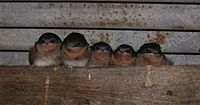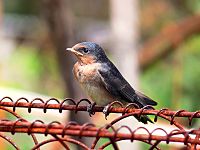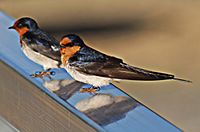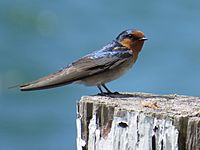Welcome swallow facts for kids
Quick facts for kids Welcome swallow |
|
|---|---|
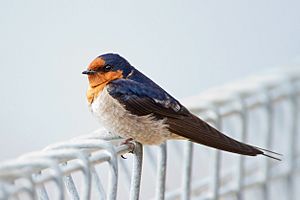 |
|
| Risdon Brook Park in Tasmania | |
| Conservation status | |
| Scientific classification | |
| Genus: |
Hirundo
|
| Species: |
neoxena
|
The welcome swallow (Hirundo neoxena) is a small bird from the swallow family. These birds are known for their fast, graceful flight.
They originally come from Australia and nearby islands like Melanesia. In the mid-1900s, they flew to New Zealand on their own and started living there. The welcome swallow looks a lot like the Pacific swallow.
These birds build their nests in southern and eastern Australia. They like open spaces, clearings made by people, and even cities. However, you won't find them in deserts or thick forests. Swallows from eastern Australia often migrate to northern Australia for winter. But birds in western Australia and New Zealand usually stay in one place.
Contents
About the Welcome Swallow
The welcome swallow was first described by John Gould in his book The birds of Australia. Its name, "welcome swallow," comes from people being happy to see it return. They saw it as a sign that spring was coming in southern Australia.
What Does a Welcome Swallow Look Like?
The welcome swallow is a small, fast-flying bird. They fly in circles with quick, darting movements. They often fly alone, in pairs, or in small groups.
Their upper body is a shiny blue-black color. Their chest and belly are light grey. Their forehead, throat, and upper chest are a rusty color. They have a long, forked tail with white spots on each feather.
These birds are about 15 cm (6 inches) long. This length includes their outer tail feathers, which are a bit shorter on females. A welcome swallow usually weighs between 9 and 20 grams (about 0.3 to 0.7 ounces).
Their call is a mix of soft chirps and warbling sounds. They make a sharp whistle if they are in danger. However, their calls are usually quiet and don't travel very far.
Young welcome swallows look a bit different. Their forehead and throat are a creamy white color instead of rusty. They also have shorter tail feathers.
Where Do Welcome Swallows Live?
Welcome swallows live in many different places because they are found across several regions. They mostly live in eastern, western, southern, and central Australia.
Global Range of Welcome Swallows
Welcome swallows from eastern Australia fly north for the winter. This takes them closer to the equator where the weather is warmer. In spring, they fly back to southern Australia to breed. Swallows in Western Australia and New Zealand usually do not migrate.
This type of swallow has been seen nesting in most parts of New Zealand and its nearby islands. They also live in Australia and parts of Tasmania. You can also find them in New Guinea, New Caledonia, and other surrounding islands.
Welcome Swallows in New Zealand
The welcome swallow flew to New Zealand from Australia on its own. This likely happened in the early 1900s. You can find welcome swallows in most parts of New Zealand, but they are very rare in Fiordland. New Zealand's long, narrow shape helped the birds easily reach areas near water. They are also found on Chatham and Kermadec Islands. Sometimes, they have been seen on Campbell Island, Auckland Island, and the Snares.
Welcome swallows often live close to people. You can commonly see them resting on wires, posts, and other places.
Life Cycle and Reproduction
Once a welcome swallow is grown, it has a long breeding season. They usually have one partner for life. Their breeding time lasts from August until March.
Nesting Habits
Both male and female swallows build their nests. The nest is shaped like an open cup and is made of mud and grass. They attach it to structures like vertical rock walls or buildings. The inside of the nest is lined with feathers and fur.
They usually lay three to five eggs. Often, they will raise two groups of chicks in one season. Nests can be found from 0.5 meters (1.6 feet) to 13.5 meters (44 feet) high. Studies show that higher nests often have more chicks survive. This might be because it's harder for animals to reach them.
Swallows build their nests in many different places. These include cities, towns, farms, boats, hollow trees, caves, cliffs, mine tunnels, and even underground water tanks. They build cup-shaped nests on vertical walls to avoid too much sunlight.
Nests take about 8 to 23 days to build. Swallows often use the same nest for breeding year after year. They usually work in pairs when breeding. However, they sometimes form small groups to protect their nests from birds that might try to attack them.
Eggs and Chicks
A pair can have up to three groups of chicks in a year. Each group, or clutch, can have two to seven eggs, but usually has four. Eggs laid at the start of the breeding season tend to be larger. Eggs are laid every 24 to 48 hours. Sometimes, a pair might leave a nest if there are too few eggs. Then, another pair might lay their eggs in that same nest.
The eggs are about 18 mm (0.7 inches) long and 13 mm (0.5 inches) wide. They are pink with brown speckles. The male welcome swallow does not sit on the eggs to keep them warm. The female does this alone. While she is incubating, the male looks for food. If the female leaves the nest to find food, the male might watch the nest for a short time or go with her.
The eggs hatch after two to three weeks. Both parents feed the young birds. The chicks leave the nest after another two to three weeks. The male swallows have been seen helping to remove waste from the nest.
Young swallows stay in the nest for 18 to 23 days. They become fully independent around 35 days old. However, they don't start breeding until they are 8 to 14 months old. Even though swallows are monogamous, sometimes more than just the breeding pair will help care for the young.
Many swallows might live together in a nest, especially when they are not breeding. They form large groups to roost together. Welcome swallows can also tell us about the temperature. When the temperature drops very low (below -2 or -3 degrees Celsius), you are less likely to see swallows in the south.
During non-breeding seasons, swallows might migrate to find more food. These trips can be quite long, especially in winter when food is scarce. Some welcome swallows have been known to live up to 6 years.
What Do Welcome Swallows Eat?
These birds are very good at flying. They catch and eat insects while flying. They often fly fast and low over open fields in large circles. They will also swoop around animals or people in open areas.
Males and females often look for food together during the breeding season, even when they have chicks in the nest. Welcome swallows also drink water while flying. They scoop water from the surface of lakes and ponds with their bills. They need to drink water often. This also helps them catch insects that are near the water. Welcome swallows can even work with other birds to gather insects together. They can remember when insects are most active to find food more easily.
Predators and Health of Welcome Swallows
Hawks, snakes, minks, and wild cats are the main animals that hunt welcome swallows. In Australia, snakes are especially dangerous. Snakes can climb trees to reach nests and eat the eggs or young birds.
One study in New Zealand found that nests only failed if they were disturbed during the time the eggs were being kept warm. This disturbance could come from humans, mammals like weasels, or other birds eating the eggs.
Swallow nests can contain different types of bacteria and parasites. These can cause diseases like histoplasmosis, encephalitis, salmonella, meningitis, and toxoplasmosis. Young chicks get protection from diseases from their mother's antibodies in the egg. Swallows often live in groups, which means they are at a higher risk for parasites. This might lead to fewer successful broods, but it also helps their immune system get stronger.
Another disease that affects welcome swallows is fowlpox. This virus has two forms: one that causes mild harm and one that can be deadly. Farm birds are usually vaccinated for this virus, but wild birds are not.
Interesting Facts About Welcome Swallows
Recent studies show that welcome swallows' wings grow slowly. This growth is not affected by how much food they eat, unless they are starving. This means that the welcome swallow makes sure its wings grow well, even if it doesn't eat for up to six hours.
It is also thought that swallows store fat in their bodies. This helps them survive when food is hard to find or when conditions are bad. This way, they can grow quickly when conditions are good and keep growing steadily when conditions are not so good.
Various Views and Plumages
See also
 In Spanish: Golondrina australiana para niños
In Spanish: Golondrina australiana para niños



